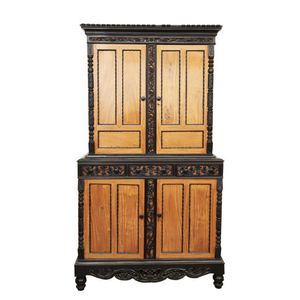Anglo-Indian Satinwood & Ebonised Cabinet with Carved Columns
You must be a subscriber, and be logged in to view price and dealer details.
Subscribe Now to view actual auction price for this item
When you subscribe, you have the option of setting the currency in which to display prices to $Au, $US, $NZ or Stg.
- Turning - Any part of a piece of furniture that has been turned and shaped with chisels on a lathe. Turned sections include legs, columns, feet, finials, pedestals, stretchers, spindles etc. There have been many varieties and fashions over the centuries: baluster, melon, barley-sugar, bobbin, cotton-reel, rope-twist, and so on. Split turning implies a turned section that has been cut in half lengthwise and applied to a cabinet front as a false decorative support.
- Column - An architectural feature sometimes used for decorative effect and sometimes as part of the supporting construction. Columns should generally taper slightly towards the top. They may be plain or decorated with carving, fluting or reeding. Columns may be fully rounded or, more commonly, half-rounded and attached with glue, screws or pins to the outer stiles of doors, or the facing uprights on cabinets and bureaux.
- Cornice - The upper section of a high piece of furniture such as a bookcase, wardrobe or cabinet that sits immediately on the main structure. The cornice is usually decorated with a variety of architectural mouldings, worked either with a moulding plane or, from the later 19th century, by machine. The front and side of the cornice are mitred together, strengthened by glue blocks, and the back is generally a simple dovetailed rail to hold the structure together. Cornices are generally, though not always, fitted separately to the piece and are held in place either by screws sunk into the top board or by wooden corner blocks. A pediment may sit above the cornice, but sometimes the terms cornice and pediment are used interchangeably.
- Satinwood - Satinwood is a dense pale gold coloured timber that was imported into Britain in the second half of the 18th century, and early 19th centuries from the East Indies and the West Indies. The name derives from the satin-like surface sheen when the timber is polished.
It was used in the solid, as a veneer and in inlays. As well as furniture, satinwood was used for making musical instruments, barometers, boxes and clocks.
It will usually be found on only the very best quality objects, presumably because of of its cost at the time. - Ebonised - Timber that has been stained or lacquered black in imitation of ebony. The process has been used since the Renaissance, but is most commonly found in late 19th century furniture, sometimes gilded and turned in imitation of bamboo. Furniture with an ebonised finish is not currently in vogue, and this is reflected in the price for such pieces.
- Provenance - A term used to describe the provable history of an antique or work of art, and thus an additional aid to verifying its authenticity. Provenance can have an inflating effect on the price of an item, particularly if the provenance relates to the early settlement of Australia, a famous person, or royalty. Less significant are previous sales of the item through an auction house or dealer.
- Frieze - An architectural term denoting the flat, shaped or convex horizontal surface of furniture, between the architrave and the cornice, usually found on a cabinet or bookcase, or on desks and tables where it may include drawers, the area between the top and the legs. In ceramics, the term refers to the banding, of usually a repeating pattern, on the rims of plates and vases.
This item has been included into following indexes:
Visually similar items

A Victorian oak bedside cabinet, in quarter-cut oak crossbanded to the top, panelled to the door with flamed veneered timber framed by a reed of Tunbridge ribbon inlay and with further figured timber inlays to the canted corners and plinth base. 40 cm x 35

An exceptional Queen Anne - George I period walnut double-dome bureau bookcase of small proportions, with ogee moulded cornice above a pair of shaped moulded mirrored doors, the mirrors with soft edge bevels and cut with attractive starbursts and crescents


A fine English 18th century Chinoiserie bureau bookcase. 246 cm high, 97 cm wide, 56 cm deep
